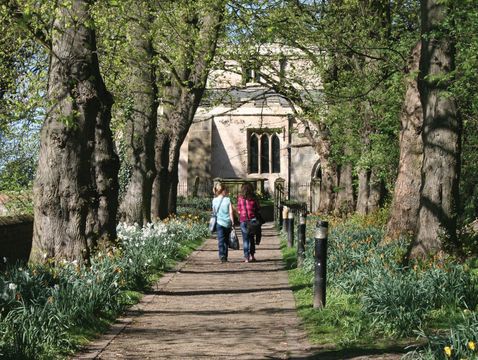
Lincolnshire, full of delights and often overlooked.
An oft-overlooked tourist site, Lincolnshire is one that all American visitors should add to their bucket list, says Dana Huntley.
Among the most overlooked and little-visited regions of Britain is the East Midlands. It is just too easy to pass by when traveling from London toward popular Yorkshire, the North Country, and Scotland. Perhaps the county most unjustly missed by American visitors is Lincolnshire.
Oozing with history, varied in character and welcoming in the friendliness of its people, England’s third-largest county lies in an awkward location. With the M1 some 40 miles to the west and the A1(M) just weaving along its western border, road travelers between north and London don’t even pass through. Its county town and cathedral city, Lincoln, where castle and cathedral have been major players in 1,000 years of English history, is a hub surrounded by a cornucopia of towns and landscapes that I have long loved to share with travelers and BHT readers.
Lincoln
The ancient city of Lincoln owes its prominence to its hilltop location. There, towering over the flat plains of arable farmland surrounding, Lincoln Castle and Lincoln Cathedral perch side by side – massive fortresses of church and state. Originally the site of a Roman fort, William the Conqueror constructed Lincoln Castle, beginning in 1068. Uniquely, the 11th-century castle has been in constant official use since then. In the 19th century, it was the site of a Victorian prison, through the 20th century it was the local magistrate's court, and today provides a new, secure home for Lincoln Cathedral’s copy of the Magna Carta.
Separated just a few hundred yards from the castle by a cobbled piazza, Lincoln Cathedral was begun in 1072 by the Norman bishop Remigius. Fire, earthquake and other acts of God and politics led to it taking 300 years to complete what remains the third largest cathedral in England – and architectural glory.
Take the cobbled pedestrian street down aptly named Steep Hill to the shopping centers and busy riverfront of the modern city of around 100,000.
Read more: Lindum Colonia - ecclesiastical powerhouse and Norman fortress
Stamford
In the southwest corner of the county, the market town of Stamford has been called England’s prettiest stone town, for its five medieval parish churches and its largely Georgian town center. As the first night’s layover on the once busy stagecoach route north, Stamford gained renown for its coaching inns. Of which several remain. The Great North Road followed the route from London to York and Edinburgh largely marked by the present A1 motorway.
Adjoining the town lies the estate of Burghley House. Built originally by Sir William Cecil, counselor and treasurer of Queen Elizabeth I, the grand Elizabethan treasure house was constructed between 1555 and 1587. Its present form and interiors date from the 18th century when “Capability” Brown landscaped the park. The mansion sits in 2,000 acres of gardens and park with a deer herd of 400. After 16 generations, the Cecil family still retains the house and Burghley estates, along with the title Marquess of Exeter.
Grantham
North along Lincolnshire’s western border, Grantham is another pretty, well-kept town center of shops, flowers, and former coaching inns. The pristine park across from Grantham’s Victorian town hall highlights a statue of Isaac Newton, who was born nearby at Woolsthorpe Manor and educated in Grantham. A plaque on the brick wall above a corner shop, near the town center, marks the birthplace of Margaret Thatcher. Britain’s feisty first woman Prime Minister grew up here, helping her father in the family grocery store.
Read more: The history of St. Botolph's & John Cotton
Boston
To the southeast, Lincolnshire shares flat, fertile Fenland with Norfolk and Cambridgeshire. This is England’s richest market garden, growing everything from bulb flowers to Brussels sprouts. The fens meet the wolds in the market town of Boston – one of England’s richest ports in the 15th-17th centuries. Profits of that wool trade across the North Sea contributed to the building of St. Botolph’s Church – among the largest parish churches in the country. Known colloquially for centuries as the “Boston Stump,” St Botolph’s 272-foot tall lantern tower can be seen for miles across the fens.
American connections to Boston run deep, of course. The Pilgrim Fathers were detained and imprisoned here, in 1607, trying to flee England for the Netherlands. St Botolph’s vicar, Rev. John Cotton, inspired the Puritan exodus that, in 1630, founded Massachusetts Bay Colony and the town that soon was to be named Boston.
Skegness
At the easternmost point on Lincolnshire’s long North Sea coast, Skegness is a classic, traditional seaside beach town, and one of my favorites. Its mascot, The Jolly Fisherman, has been welcoming holidaymakers since 1908. It’s worth noting that this is the North Sea and the water is cold. A long, wide strand of clean sandy beach, with seafront hotels, pier, amusements, and donkey rides, and the traditional seaside pubs, shops and eateries: Skegness has it all. The town is shipshape, friendly, and not too big to feel impersonal.
Epworth
Toward the northwest corner of Lincolnshire, the small market town of Epworth would be easy to travel past on the M123.
In many ways, Epworth is a quintessential small town. It is also the birthplace of John and Charles Wesley, where their father, Rev. Samuel Wesley was rector of the parish church of St. Andrew. The parsonage where the founders of Methodism spent their boyhood tells the story.
Read more: What would Jane Austen do? A tour in the West Country





Comments